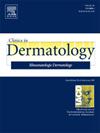介绍用于诊断臀间裂皮肤病的本德体征。
IF 2.3
4区 医学
Q2 DERMATOLOGY
引用次数: 0
摘要
本杰明-本德博士(1908-1996 年)是纽约州立大学下州医学院皮肤科的长期临床教授。大约 45 年前,他创造了 "本德手势 "这个外号,用来描述通过让患者弯腰,然后用手分开臀部来发现涉及臀沟的皮肤病。班德的外号是一个幽默的双关语,涉及他的名字 "班德 "和病人的 "弯腰"。这篇论文正式将这一有趣的外来语引入皮肤病学文献中,并强烈推荐将其作为一种教学工具,以提醒学生检查臀间沟区域的重要性,因为该区域往往隐藏着各种皮肤疾病,如银屑病。本文还介绍了第二个本德征象,即本德征象 2 号,它描述了当面部因神经性皮炎而受到摩擦和发炎时,鼻子会受到损伤。这篇文章是为了向本杰明-本德博士致敬,他是学生们敬爱的皮肤病学大师。本文章由计算机程序翻译,如有差异,请以英文原文为准。
Introducing the Bender sign for the diagnosis of intergluteal cleft skin disorders
Dr Benjamin Bender (1908-1996) was a longtime Clinical Professor of Dermatology at the State University of New York Downstate College of Medicine. Some 45 years ago, he coined the eponym Bender sign, which describes the discovery of cutaneous diseases that involve the gluteal cleft by having patients bend over and then manually separating the buttocks. Bender's eponym was created as a humorous pun involving his name “Bender” and the “bending” of the patient. This contribution formally introduces this delightful eponym into the dermatology literature and highly recommends its adoption as a teaching tool to remind students of the importance of examining the intergluteal cleft area, which can often harbor a variety of skin disorders, such as psoriasis. A second Bender sign, referred to as Bender sign #2, is also presented, which describes the sparing of the nose when the face is rubbed and inflamed from neurodermatitis. This contribution pays tribute to Dr Benjamin Bender, a beloved master teacher of dermatology.
求助全文
通过发布文献求助,成功后即可免费获取论文全文。
去求助
来源期刊

Clinics in dermatology
医学-皮肤病学
CiteScore
4.60
自引率
7.40%
发文量
106
审稿时长
3 days
期刊介绍:
Clinics in Dermatology brings you the most practical and comprehensive information on the treatment and care of skin disorders. Each issue features a Guest Editor and is devoted to a single timely topic relating to clinical dermatology.
Clinics in Dermatology provides information that is...
• Clinically oriented -- from evaluation to treatment, Clinics in Dermatology covers what is most relevant to you in your practice.
• Authoritative -- world-renowned experts in the field assure the high-quality and currency of each issue by reporting on their areas of expertise.
• Well-illustrated -- each issue is complete with photos, drawings and diagrams to illustrate points and demonstrate techniques.
 求助内容:
求助内容: 应助结果提醒方式:
应助结果提醒方式:


